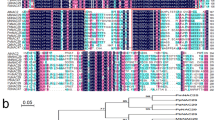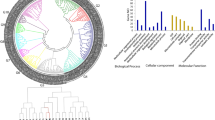Abstract
An auxin response factor 2 gene, MiARF2, was cloned in our previous study [1] from the cotyledon section of mango (Mangifera indica L. cv. Zihua) during adventitious root formation, which shares an 84% amino acid sequence similarity to Arabidopsis ARF2. This study was to examine the effects of over-expression of the full-length MiARF2 open reading frame on the root and hypocotyl growth in Arabidopsis. Phenotype analysis showed that the T3 transgenic lines had about 20–30% reduction in the length of hypocotyls and roots of the seedlings in comparison with the wild-type. The transcription levels of ANT and ARGOS genes which play a role in controlling organ size and cell proliferation in the transgenic seedlings also decreased. Therefore, the inhibited root and hypocotyl growth in the transgenic seedlings may be associated with the down-regulated transcription of ANT and ARGOS by the over-expression of MiARF2. This study also suggests that although MiARF2 only has a single DNA-binding domain (DBD), it can function as other ARF-like proteins containing complete DBD, middle region (MR) and carboxy-terminal dimerization domain (CTD).




Similar content being viewed by others
References
Xiao JN, Huang XL, Zhang YS, Li Y, Li XJ (2004) Cloning of cDNA fragments related to adventitious root formation from mango cotyledon section. J Plant Physiol Mol Biol 30:136–140
Morris DA, Friml J, Zazimalova E (2004) The transport of auxins. In: Davies PJ (ed) Plant hormones: biosynthesis, signal transduction, action. Kluwer Academic Publisher, Dordrecht, pp 437–470
Abel S, Theologis A (1996) Early genes and auxin action. Plant Physiol 111:9–17
Leyser O (2002) Molecular genetics of auxin signaling. Annu Rev Plant Biol 53:377–398
Guilfoyle TJ, Ulmasov T, Hagen G (1998) The ARF family of transcription factors and their role in plant hormone responsive transcription. Cell Mol Life Sci 54:619–627
Liscum E, Reed JW (2002) Genetics of Aux/IAA and ARF action in plant growth and development. Plant Mol Biol 49:387–400
Hagen G, Guilfoyle T (2002) Auxin-responsive gene expression: genes, promoters and regulatory factors. Plant Mol Biol 49:373–385
Ulmasov T, Hagen G, Guilfoyle T (1999) Activation and repression of transcription by auxin-response factors. Proc Natl Acad Sci USA 96:5844–5849
Faivre-Rampant O, Cardle L, Marshall D, Viola R, Taylor MA (2004) Changes in gene expression during meristem activation processes in Solanum tuberosum with a focus on the regulation of an auxin response factor gene. J Exp Bot 55:613–622
Saito Y, Yamasaki S, Fujii N, Hagen G, Guilfoyle T, Takahashi H (2004) Isolation of cucumber CsARF cDNAs and expression of the corresponding mRNAs during gravity-regulated morphogenesis of cucumber seedlings. J Exp Bot 55:1315–1323
Waller F, Furuya M, Nick P (2002) OsARF1, an auxin response factor from rice, is auxin-regulated and classifies as a primary auxin responsive gene. Plant Mol Biol 50:415–425
Jones B, Frasse P, Olmos E, Zegzouti H, Li ZG, Latché A, Pech JC, Bouzayen M (2002) Down-regulation of DR12, an auxin-response-factor homolog, in the tomato results in a pleiotropic phenotype including dark green and blotchy ripening fruit. Plant J 32:603–613
Ulmasov T, Hagen G, Guilfoyle TJ (1997) ARF1, a transcription factor that binds to auxin response elements. Science 276:1865–1868
Tiwari SB, Hagen G, Guilfoyle T (2003) The roles of auxin response factor domains in auxin-responsive transcription. Plant Cell 15:533–543
Ulmasov T, Murfett J, Hagen G (1997) Guilfoyle TJ, Aux/IAA proteins repress expression of reporter genes containing natural and highly active synthetic auxin response elements. Plant Cell 9:1963–1971
Ulmasov T, Hagen G, Guilfoyle T (1999) Dimerization and DNA binding of auxin response factors. Plant J 19:309–319
Kim J, Harter K, Theologis A (1997) Protein–protein interactions among the Aux/IAA proteins. Proc Natl Acad Sci USA 94:11786–11791
Ouellet F, Overvoorde PJ, Theologis A (2001) IAA17/AXR3: biochemical insight into an auxin mutant phenotype. Plant Cell 13:829–841
Guilfoyle TJ, Hagen G (2001) Auxin response factors. J Plant Growth Regul 10:281–291
Remington DL, Vision TJ, Guilfoyle TJ, Reed JW (2004) Contrasting modes of diversification in the Aux/IAA and ARF gene families. Plant Physiol 135:1738–1752
Chen QZ (2007) Function study of mango (Mangifera indica L.) auxin response factor like gene MiARF2 during the adventitious root formation. Doctor’s Degree Paper, China
Tatematsu K, Kumagai S, Muto H, Sato A, Watahiki MK, Harper RM, Liscum E, Yamamoto KT (2004) MASSUGU2 encodes Aux/IAA19, an auxin-regulated protein that functions together with the transcriptional activator NPH4/ARF7 to regulate differential growth responses of hypocotyl and formation of lateral roots. Plant Cell 16:379–393
Tian C, Muto H, Higuchi K, Matamura T, Tatematsu K, Koshiba T, Yamamoto KT (2004) Disruption and overexpression of auxin response factor 8 gene of Arabidopsis affect hypocotyl elongation and root growth habit, indicating its possible involvement in auxin homeostasis in light condition. Plant J 40:333–343
Schruff MC, Spielman M, Tiwari S, Adams S, Fenby N, Scott RJ (2005) The AUXIN RESPONSE FACTOR 2 gene of Arabidopsis links auxin signalling, cell division, and the size of seeds and other organs. Development 133:251–261
Guilfoyle TJ, Hagen G (2007) Auxin response factors. Curr Opin Plant Biol 10:453–460
Okushima Y, Mitina I, Quach HL, Theologis A (2005) AUXIN RESPONSE FACTOR 2 (ARF2): a pleiotropic developmental regulator. Plant J 43:29–46
Li H, Johnson P, Stepanova A, Alonso JM, Ecker JR (2004) Convergence of signaling pathways in the control of differential cell growth in Arabidopsis. Dev Cell 7:193–204
Ellis CM, Nagpal P, Young JC, Hagen G, Guilfoyle TJ, Reed JW (2005) AUXIN RESPONSE FACTOR 1 and AUXIN RESPONSE FACTOR 2 regulate senescence and floral abscission in Arabidopsis thaliana. Development 132:4563–4574
Krizek BA (1999) Ectopic expression of AINTEGUMENTA in Arabidopsis plants results in increased growth of oral organs. Dev Genet 25:224–236
Mizukami Y, Fischer RL (2000) Plant organ size control: AINTEGUMENTA regulates growth and cell numbers during organogenesis. Proc Natl Acad Sci USA 97:942–947
Oakenfull EA, Riou-Khamlichi C, Murray JAH (2002) Plant D-type cyclins and the control of G1 progression. Philos Trans R Soc Lond B 357:749–760
Hu Y, Xie Q, Chua NH (2003) The Arabidopsis auxin-inducible gene ARGOS controls lateral organ size. Plant Cell 15:1951–1961
Murashige T, Skoog F (1962) A revised medium for rapid growth and bioassays with tobacco tissue cultures. Physiol Plant 15:473–497
Hood EE, Gelvin SB, Melchers LS, Hoekema A (1993) A new Agrobacterium helper plasmids for gene transfer to plants. Transgenic Res 2:208–218
Clough SJ, Bent AF (1998) Floral dip: a simplified method for Agrobacterium-mediated transformation of Arabidopsis thaliana. Plant J 16:735–743
Sambrook J, Russell DW (2001) Molecular cloning: a laboratory manual, 3rd edn. Cold Spring Harbor Laboratory Press, Cold Spring Harbor
Weigel D, Glazebrook J (2002) Arabidopsis: a laboratory manual. Cold Spring Harbor Laboratory Press, Cold Spring Harbor
Leyser HMO, Lincoln CA, Timpte C, Lammer D, Turner J, Estelle M (1993) Arabidopsis auxin resistance gene AXR1 encodes a protein related to ubiquitin activating enzyme E1. Nature 364:161–164
Rouse D, Mackay P, Stirnberg P, Estelle M, Leyser O (1998) Changes in auxin response from mutations in an AUX/IAA gene. Science 279:1371–1373
Collett CE, Harberd NP, Leyser O (2000) Hormonal interactions in the control of Arabidopsis hypocotyl elongation. Plant Physiol 124:553–561
Wei HB, Cui BM, Ren YL, Li JH, Liao WB, Xu NF, Peng M (2006) Research progresses on auxin response factors. J Integr Plant Biol 48:622–627
Acknowledgments
The authors are grateful to Dr. Xie Qi for his valuable discussion and the gift of the pBA002 vector. This research was supported by the Natural Science Foundation of China 30470110.
Author information
Authors and Affiliations
Corresponding authors
Rights and permissions
About this article
Cite this article
Wu, B., Li, YH., Wu, JY. et al. Over-expression of mango (Mangifera indica L.) MiARF2 inhibits root and hypocotyl growth of Arabidopsis . Mol Biol Rep 38, 3189–3194 (2011). https://doi.org/10.1007/s11033-010-9990-8
Received:
Accepted:
Published:
Issue Date:
DOI: https://doi.org/10.1007/s11033-010-9990-8




